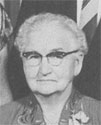
 |
||
| Home Page | Wetaskiwin Businesses | Community Organizations | Municipal Index | Maps | Site Map | Contact Us | | Photo Ads| | Camrose Online | Ponoka Online | ||
| History of Wetaskiwin: All information within has been provided by the Wetaskiwin & District Heritage Museum. |
| Search For Other Stories: Back to Women of Aspenland List |
 Topic: The Women of Aspenland
Topic: The Women of AspenlandArticle: Lydia (Lechelt) Burghardt Date Posted: August 26/2012 Main District: Wetaskiwin Decades: 1880's to 1980's
Lydia Lechelt was born February 2, 1884, in Wolynnia, Russia. Her father, Karl Lechelt, was educated in teaching and Lutheran theology. At the age of seventeen, he started teaching for a congregation in Poland. When many of his congregation moved to Russia, he moved with them. However, freedoms in Russia were eroding. The law provided for people to own land and homes, but at death the property belonged to the government, and could not be inherited by their children. Seeking a better life, families picked up their belongings and headed for the "great free land" called Canada. Lydia was nine when her parents, Karl and Amalia Lechelt, three brothers and two sisters came to Canada. Because their father was a teacher, the children were schooled at home in the winter. The first financial help Lydia was able to give her family was through baby-sitting, scrubbing floors, etc. for $2.50 per month. Later she was to work for several years as a waitress in Edmonton and Leduc, receiving $10.00 per month. The Lechelts' first home was destroyed by fire. Neighbours came to help rebuild the log house; someone gave them boards for the door. The roof was covered with bundles of straw, and this roof lasted for twenty years. The house had no floor, only the bard ground. Lydia was very proud at this time to be able to buy a new suit for her father, for $11.50; this was very necessary for him as the local minister and teacher. On December 13, 1905, she married a neighbour, Henry Burghardt, who was born in Lublin, Poland, and had moved with his family to Canada in 1899. The young couple came to the Brightview district in search of a homestead in 1906, however, they were disappointed to find all available homesteads had been claimed. In 1907, they purchased a quarter section of C.P.R. land, NW25-46-26-W4, for $7.00 an acre. This was uncleared land which required much hard labour. To earn money, the young couple cut firewood. They worked together cutting and sawing the firewood, then on the days that Henry took a load to town to sell, Lydia would stay at home splitting the wood. They were able to earn $5.00 from their two days of hard labour. They had brought two cows and one sow with them from their parents' homes. These, with chickens, wild partridges and rabbits, as well as a garden, supplied most of their food. Rabbits were caught by digging a hole and covering it with light branches and hay. When the rabbits came to nibble the hay, they would fall through into the hole and be trapped. One of the challenges for Lydia, as a young bride, was loneliness. The closest neighbours were one and a half miles away and her only method of transportation was by foot. The Brightview Emmaus Lutheran Congregation was formed in 1909. Lydia was a charter member. This was a very important part of her life and she became very involved with the ladies group, collecting to buy altar items, and serving as treasurer of the ladies' group. Visiting on Sunday after church was the main social life. People shared what they had and enjoyed each others' company. The Burghardts had three children, William, Otto, and Alma (Mrs. Emil Lentz). Lydia was very involved in her children's education. The teacher was often invited over for supper. Henry and Lydia purchased their first automobile in 1918; they paid $800. It had curtains on the window and no heater, so it was very cold to ride in in the winter. They were one of the first families in the area to acquire a radio. Tragedy in the form of a fire struck a second time in Lydia's life. The Burghardt home was destroyed on December 23, 1934. The family was left with only the clothes they were wearing. Again, relatives and neighbours came to their aid and soon a granary was made ready for them to move into, and later a new house. Two of the Burghardt children were married during the Depression. Because of the hard times, they continued to live with their parents until they were able to establish homes of their own. When they were able to move out, her daughter says she was always only a phone call away, ready to help.
The Burghardts lived on their farm until 1964, when they retired and moved to Wetaskiwin. Henry died one year later. Lydia continued to live in her house, spending much time doing needlework, especially crocheting. She later moved to Luther Manor. Lydia passed away in 1988 at the age of one hundred and four. Information compiled in 1997.
|
| Feedback: On behalf of Wetaskiwin Online I am pleased to offer these historical articles from the Wetaskiwin and District Museum for all our online viewers.
Should you have feedback regarding any of these articles please contact the Museum using the information further below.
Sincerely: Wetaskiwin & District Heritage Museum 5007 - 50 Avenue Wetaskiwin, Alberta T9A 0S3 Email: |